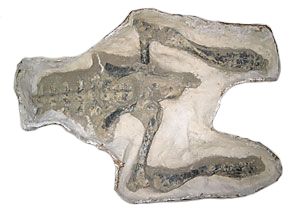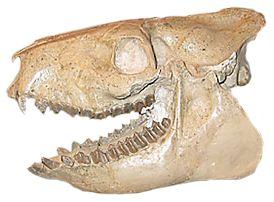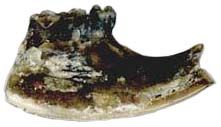
Nebraska County Fossils
Dawes
< Vertebrate Paleontology Home
A virtual journey through the Museum's vertebrate paleontology collection.
Merycochoerus, Oreodont
Family: Merycoidodontidae
Geologic age: Miocene, about 18 million years old
Year fossil collected: 1998


This large block of sandstone contains three complete and articulated skeletons of the oreodont Merycochoerus. The hindquarters of one (left) has been partially prepared, and the skulls of two others (below) are beginning to appear as preparation on the big block continues. This important specimen was found at the same site as Stratimus strobeli, but 23 years latter! Regular monitoring of sites is an essential element in preserving Nebraska's fossil heritage.
Merycoidodon culbertsoni, Culbertson's oreodont
Family: Merycoidodontidae
Geologic age: Oligocene, about 30 million years old
Year fossil collected: 1968


This nicely preserved skull of Merycoidodon was collected in 1968 in Dawes County. Even though oreodonts were among the most common mammals in Nebraska during the Oligocene, that doesn't mean they aren't important. What makes a fossil important? Can you tell the difference between a scientifically important fossil and a scientifically unimportant one? Find out!
Stratimus strobeli, Strobel's paved road mouse
Family: Heteromyidae
Geologic age: Miocene (Arikareean), about 18 million years old
Year fossil collected: 1975


On the Dawes County page, this jaw of Strobel's paved road mouse looks about as large as an oreodont, but as the picture at left shows, it is really quite small. Microfossils such as this are very important indicators of the ancient climate and habitat. This new species was discovered by staff of the Highway Salvage Paleontology program, a joint effort between the University of Nebraska State Museum and the Nebraska Department of Roads. Stratimus strobeli was named for Jerry Strobel, director and state engineer of the Nebraska Department of Roads from 1987 to 1991.
Geological Ages of Rock Formations

| Q | Pleistocene ("Ice Age") Sands, gravels, silts overlay much of the county (not shown) Pleistocene sands, gravels and silts overlay much of Nebraska and often conceal the bedrock beneath. These "Ice Age" deposits often produce the remains of mammoths, bison, horses, musk oxen, elk and other familiar mammals. Small fossils, especially, are important indicators of the climate at the time of deposition. |
| Tm | Tertiary, Miocene, Hemingford/Arikaree Group, 15-28 million years old The Hemingford/Arikaree group includes the Miocene Sheep Creek, Upper Harrison, Harrison, Monroe Creek and Gering Formations. These rocks typically form the higher relief ridges as seen throughout the Pine Ridge area of Nebraska. These fine to medium grained sandstones contain considerable volcaniclastic material and indicate high volcanic activity in the west. Fossils from these rocks document the transition from a forest habitat to an open grassland habitat. |
| To | Tertiary, Oligocene, White River Group, 28-40 million years old The White River Group rocks include the Chadron and Brule Formations often form large expanses of low to medium-relief badlands typical of western Nebraska (Toadstool Park) and South Dakota (Big Badlands). Siltstones and very fine sandstones dominate these units. The White River Group rocks preserve the early history of horses, rhinos and camels, all of which originated in North America. The habitats across much of the state at the time were distinctly un-Nebraskan, with low-crowned browsing mammals (forest dwellers) and their predators composing the dominant fauna. |
| Kp | Cretaceous, Pierre Formation, 66-78 million years old The Upper Cretaceous Pierre Formation was deposited in the deeper portions of the Cretaceous mid-continental seaway. It consists primarily of fine black shales. Roads and structures built on Pierre Shale hillsides often slump as the shale becomes wet. The unit produces a variety of marine vertebrate fossils including fish, mosasaurs and plesiosaurs. |
| Kn | Cretaceous, Niobrara Formation, 80-88 million years old The Niobrara Formation is composed predominantly of grey to yellow chalk and chalky shale. It is well exposed along the southern and northeastern borders of Nebraska, although outcrops are generally limited to vertical cliffs. In Nebraska, this unit produces the same fauna as found in the well developed badlands of western Kansas. Fossils include large fish, mosasaurs and pterosaurs, but due to limited exposures, fossils are found less frequently than in Kansas. |
| Kc | Cretaceous, Carlisle Formation, 88-92 million years old The Cretaceous Carlisle Shale is composed of a series of dark green to olive sediments ranging from chalk to shale to sandstone, indicating a shallowing of the sea that once covered mid-America. Several transgressions (change in sea level/position of shorelines) took place during the Cretaceous. |
| Kgg | Cretaceous, Greenhorn/Graneros Formations, 92-96 million years old The Graneros Shale/Greenhorn Limestone Formations indicate a transition from a lagoonal/deltaic environment dominated by shales to a deeper water environment where limestone is the predominant sediment. The contact between these formations is usually recognized by a distinctive altered volcanic ash layer (the X-bentonite). |





